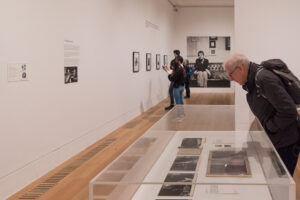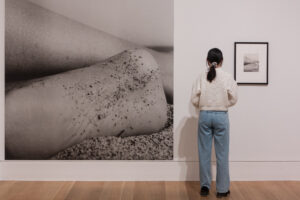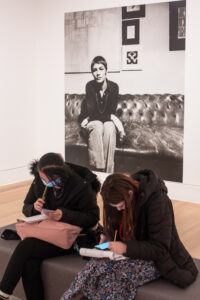How much does one need, or want, to know about a photographer’s work?
Bill Brandt (1904–1983) was a leading British photographer from the 1930s through to the 1960s, a period of innovation and rapid growth in the practice and public availability of the art in galleries and illustrated magazines. Bill Brandt: Inside the Mirror, was on show at Tate Britain from 17th October 2022 to 15th January 2023 and brought together 44 original photographs from across his career displayed alongside magazines and photobooks. Organised in four sections, ‘Staging’, ‘Abstraction’, ‘Poetry’ and ‘People Places’, it showed his work that merged documenting daily life with art, the real with the surreal. Some of his most well-known images were included – landscapes, abstract nudes, night time in London, domestic life in the 1930 and portraits of artists and writers. It showed his work being inspired by influences as diverse as Citizen Kane, Alice in Wonderland and the sculpture of Henry Moore.
The Tate explained that: ‘This exhibition of works in the Tate’s collection reveals how Brandt changed his practice throughout his career and crafted each photograph to capture the surreal beauty he saw in the everyday.’ The result was a hybrid: part an exhibition of Brandt’s art to be appreciated as just that, for all its diversity; and part an exploration of his practice and how he achieved the finished work. Many people with an interest in photography will have some familiarity with the former; they and others will know less about the latter and may be surprised to learn that things are not always what they seem. Brand’s famous nudes are plainly distorted and manipulated, but the degree of manipulation is much less apparent in the documentary work.
A quote from Brandt at the beginning of the exhibition sets out his philosophy: ‘A photographer is allowed to do anything, anything, in order to improve his pictures.’ The exhibition text explains: ‘…a director he planned, sketched, staged and directed each shot to suggest significance, stories and a sense of the surreal in the everyday.’ For ‘A Night in London’ (1938) he set up scenes in daylight and waited for the light to fade. Brandt did not seek to capture people unawares: he believed a more meaningful kind of realism was achieved by engaging and gaining cooperation with those he photographed. This went so far as using his wife, Eva, and brother, Rolf, to act out parts.
The artifice didn’t stop there. Negatives and prints were manipulated using techniques such as cropping, enlarging and retouching with ink or pencil and scratching away part of the picture surface (the emulsion). Brandt was also happy to create images by combination printing from negatives: his famous picture Top Withins combines the sky and foreground photographed on different occasions. What Brandt wanted from an image changed over time and he printed his photographs to reflect this, as exemplified by a series of increasingly high contrast variations on Hail, Hell and Halifax made in 1964-5, 1966 and 1977.
The Tate said: ‘This exhibition celebrates his theatrical direction of people and setting, his mastery of composition and abstraction, and his dialogues with the work of other artists.’ Indeed it did and unlike most exhibitions it not only shows what he did, but how he did it. This has two consequences. First, his ‘documentary’ work appears as a particularly contrived version of reality. All documentary work is partial (in both senses) of course: we are presented with the moment and place that photographers choose when they press the shutter. Brandt’s pictures are several steps further removed from reality. Second, issues of truth aside, the revelation of Brandt’s photographic tricks is like being shown how a magician creates an illusion, all the mystery is gone and we feel cheated. Everything is reduced to a series of technical exercises. I like to have disbelief suspended.
I shall never see Brandt’s work the same way again. I’m reminded of the famous line from the film The Man Who Shot Liberty Valance, ‘When the legend becomes fact, print the legend’.




